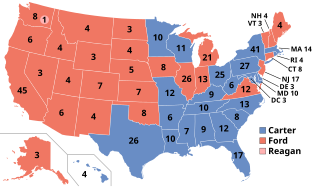
Spiro Theodore Agnew was the 39th vice president of the United States, serving from 1969 until his resignation in 1973. He is the second of two vice presidents to resign the position, the first being John C. Calhoun in 1832.

The 1968 United States presidential election was the 46th quadrennial presidential election, held on Tuesday, November 5, 1968. The Republican nominee, former vice president Richard Nixon, defeated both the Democratic nominee, incumbent vice president Hubert Humphrey, and the American Independent Party nominee, former Alabama governor George Wallace.

The 1972 United States presidential election was the 47th quadrennial presidential election held on Tuesday, November 7, 1972. Incumbent Republican President Richard Nixon defeated Democratic Senator George McGovern in a landslide victory. With 60.7% of the popular vote, Richard Nixon won the largest share of the popular vote for the Republican Party in any presidential election.

The 1976 United States presidential election was the 48th quadrennial presidential election, held on Tuesday, November 2, 1976. The Democratic nominee, former Georgia governor Jimmy Carter, narrowly defeated incumbent Republican President Gerald Ford. This was the first presidential election since 1932 in which the incumbent was defeated, as well as the only Democratic victory of the six presidential elections between 1968 and 1988.

The 1992 presidential campaign of Bill Clinton, the then-governor of Arkansas, was announced on October 3, 1991, at the Old State House in Little Rock, Arkansas. After winning a majority of delegates in the Democratic primaries of 1992, the campaign announced that then-junior U.S. senator from Tennessee, Al Gore, would be Clinton's running mate. The Clinton–Gore ticket defeated Republican incumbent President George H. W. Bush and Vice President Dan Quayle in the presidential election on November 3, 1992, and took office as the 42nd president and 45th vice president, respectively, on January 20, 1993.

The 1968 Republican National Convention was held at the Miami Beach Convention Center in Miami Beach, Dade County, Florida, USA, from August 5 to August 8, 1968, to select the party's nominee in the general election. It nominated former Vice President Richard Nixon for president and Maryland Governor Spiro Agnew for vice president. It was the fourth time Nixon had been nominated on the Republican ticket as either its vice presidential or presidential candidate (1960). Symbolic of the South's changing political affiliation, this was the first Republican National Convention held in a prior Confederate State.

The 1972 Republican National Convention was held from August 21 to August 23, 1972, at the Miami Beach Convention Center in Miami Beach, Florida. It nominated President Richard M. Nixon and Vice President Spiro T. Agnew for reelection. The convention was chaired by House minority leader and future Nixon successor Gerald Ford of Michigan. It was the fifth time that Nixon had been nominated on the Republican ticket for vice president or president. Nixon's five appearances on his party's ticket matched the major-party American standard of Franklin D. Roosevelt, a Democrat who had been nominated for vice president once and president four times. Nixon was the first Republican to be nominated three times for president—the second being Donald Trump in 2016, 2020, and 2024.

From March 7 to June 6, 1972, voters of the Republican Party chose its nominee for president in the 1972 United States presidential election. Incumbent President Richard Nixon was again selected as the nominee through a series of primary elections and caucuses culminating in the 1972 Republican National Convention held from August 21 to August 23, 1972, in Miami, Florida.

Richard Nixon served as the 37th president of the United States from 1969 to 1974. He previously served as the 36th vice president of the United States from 1953 to 1961, and as a United States senator from 1950 to 1953 and United States representative from 1947 to 1950.

The 1968 presidential campaign of Richard Nixon, the 36th vice president of the United States, began when Nixon, the Republican nominee of 1960, formally announced his candidacy, following a year's preparation and five years' political reorganization after defeats in the 1960 presidential election and the 1962 California gubernatorial election.
1968 in the United States was marked by several major historical events. It is often considered to be one of the most turbulent and traumatic years of the 20th century in the United States.

Events from the year 1970 in the United States.
Events from the year 1972 in the United States.
Events from the year 1973 in the United States. The year saw a number of important historical events in the country, including the death of former President Lyndon B. Johnson, the U.S. Supreme Court's decision on Roe v. Wade, the signing of the Paris Peace Accords and end of the United States participation in the Vietnam War, the end of the post-World War II boom and the beginning of the first of a series of recessions that continued over the next decade, and the first oil crisis.
Events from the year 1974 in the United States.

The 1972 United States presidential election in New Hampshire took place on November 7, 1972, as part of the 1972 United States presidential election, which was held throughout all 50 states and D.C. Voters chose four representatives, or electors to the Electoral College, who voted for president and vice president.

The 1972 United States presidential election in Indiana took place on November 7, 1972. All fifty states and the District of Columbia were part of the 1972 United States presidential election. State voters chose 13 electors to the Electoral College, who voted for president and vice president.

The 1972 United States presidential election in Missouri took place on November 7, 1972. All fifty states and the District of Columbia were part of the 1972 United States presidential election. Voters chose 12 electors to the Electoral College, who voted for president and vice president.















